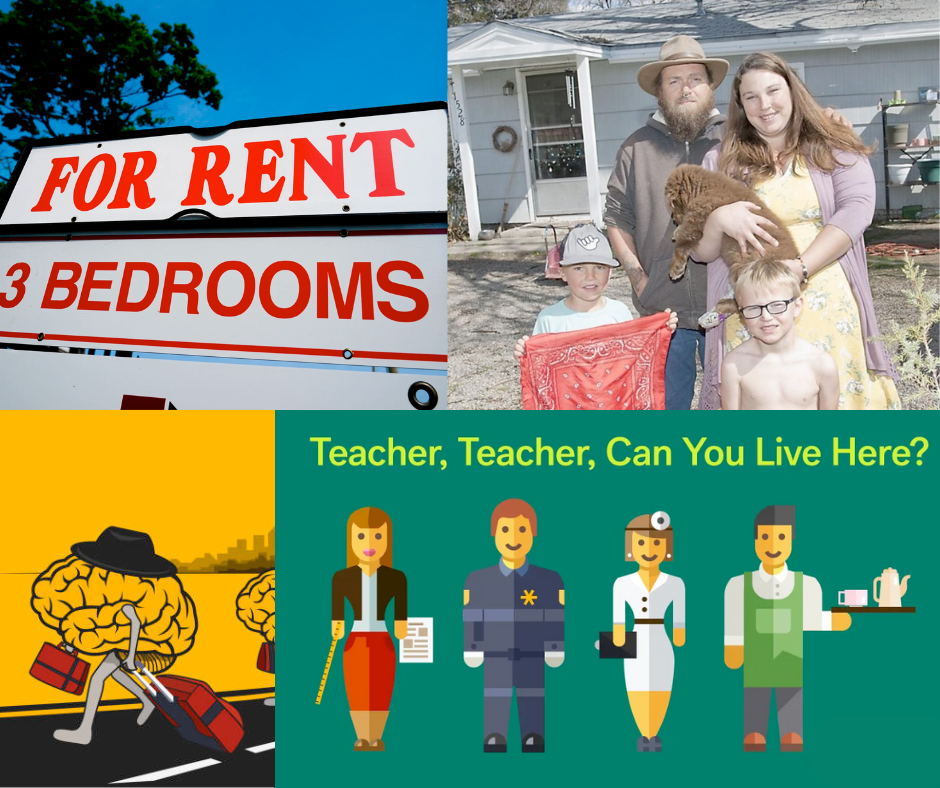This is the second article in a series looking at Wyoming’s housing crisis. Read part one here, which looks at the causes of the crisis.
The high cost of housing is a problem in and of itself. It means that working families spend too much of their paychecks on their mortgage or rent.

But the problem doesn’t stop there. Out-of-control housing costs across Wyoming filter out to cause other forms of harm to our communities.
“Lack of affordable housing in Wyoming is stifling our economy and making it hard for working-class families to establish roots,” Rep. Trey Sherwood (D-Laramie) said. “If we want our young people to stay and grow the economy, the state must invest in housing.”
From hampering local business to decreasing essential services to harming people’s overall quality of life, the lack of affordable housing is the root cause of an entire collection of other issues.
Our state must address this core problem to improve its communities and the lives of its residents.
Intensifying the brain drain
For decades, Wyoming has suffered from “brain drain”—young people leaving the state after graduation.
The cause is often economic. Young people leave because they can find better jobs and more opportunities elsewhere.
According to the Wyoming Department of Workforce Services, roughly half of the state’s high school graduates leave the state within 10 years of graduation.
Two-thirds of University of Wyoming students recently told the Wyoming Business Council that a future in the state for them was either a “maybe” or a “no.”
While a shortage of job opportunities makes Wyoming less attractive to recent grads, the lack of affordable housing makes the problem worse. This is a relatively new part of the problem, since the cost of housing was not a huge issue in most of Wyoming until recently.
Between 2020 - 2023, the median home price in Wyoming has increased 32 percent. Meanwhile, median wages in the state only increased 8.5 percent.
Even though other states might also have high housing prices, they can at least offer good paying jobs. Surrounding states like Utah and Montana face their own housing crises, but they have some of the strongest economies in the nation. Wyoming has one of the weakest.
For young people entering the workforce and looking forward to buying a home in 2024, Wyoming becomes less attractive as the cost of housing becomes something they cannot reach.
Essential services suffer
According to a survey by the Wyoming Association of Municipalities, 82.5 percent of the state’s towns and cities have a shortage of “workforce housing.” This is a term used to describe a typical middle-class home that a working family can afford.
Cokeville struggles to employ police officers who can afford to live in town. As a result, officers end up living outside the community and cannot respond promptly to calls.
The survey found that, as a result of a lack of housing, towns were having trouble retaining workers who offer basic services like education, healthcare, and law enforcement—things that any community needs.
In Guernsey, for instance, educators turned down jobs offered by the school district because they could not afford local housing on a teacher’s salary.
On the other side of the state, Cokeville struggles to employ police officers who can afford to live in town. As a result, officers end up living outside the community and cannot respond promptly to calls.
Meanwhile, comments in the survey describe the cost of housing being driven up by out-of-state cash buyers who are retiring, working remotely, or purchasing second homes.
As a result, housing becomes both unaffordable in Wyoming and not occupied by people who are contributing basic services to their local communities.
Businesses choose elsewhere
While firefighters and nurses struggle to afford homes in Wyoming, the lack of housing also keeps new businesses from locating here and stops existing businesses from growing.
In the WAM survey, officials noted that a hydrogen plant considered opening corporate offices in Saratoga but changed their mind because there is not enough housing.
Shoshoni, despite its recent renewal led by a revamped truck stop, had both a pet supplies company and a concrete company consider their town for relocation, but declined because of housing.

Brad Enzi, CEO of the Laramie Chamber Business Alliance, told Better Wyoming his organization has courted three high-tech manufacturing companies to consider opening up shop in Laramie. But each of them chose different locations, in large part because of housing.
“If someone is driving down the road with you and you’re giving them a tour of the town, inevitably at some point they’re on Zillow or Relator.com and they go, ‘There’s no homes here. Nowhere to live’” Enzi said.
The same thing has happened in Laramie with growing companies focused on technology, programming, AI, and advanced computing, he said.
“It’s all tagged back to that housing element. It’s cost and availability,” Enzi said. “The cost of a medium-priced home is approaching $400,000, and there are very few homes for sale.”
Wyoming communities simply will not be able to grow their economies unless their workforce housing problems are fixed.
Rentals crumble
In a housing market where demand far exceeds supply, the landlord is king.
With would-be renters scrambling to get into scarce units in any given Wyoming town, rental owners can inflate rates while letting their properties deteriorate. They know that pickier tenants will be followed by those who are more desperate.
Even as the price of housing skyrockets, the Wyoming Community Development Authority estimates that more than 50,000 households in Wyoming have at least one serious issue, such as the lack of adequate kitchen or plumbing facilities.
Many of these problem properties are rentals.
In Laramie, a town where nearly 50 percent of the population rents, local officials responded to the issue of slumlords renting out sub-livable properties by passing an ordinance to require that homes have basic health and safety elements, like functioning heat.
In response, landlords have organized to support city council candidates who would overturn the rental safety ordinance and they have lobbied the legislature to intervene.
Both efforts, to date, have been unsuccessful.
Stress and homelessness
Finally, a lack of affordable housing is bad for a people’s overall well-being.
“People who are affordably housed earn more in their lifetime, live longer, and their children do better in school.”
Worrying about making next month’s rent can increase stress, drive up blood pressure, and inflame mental health issues like depression. People scrambling to afford housing have less bandwidth for raising children, continuing their education, or preparing for the future.
“There are broad, long-term effects to affordable housing,” says Sarah Saadian, senior vice president at the National Low-Income Housing Coalition. “People who are affordably housed earn more in their lifetime, live longer, and their children do better in school.”
At the end of the line, a lack of affordable housing leads to homelessness. Wyoming's homeless population has grown in recent years as the availability of affordable housing has decreased. On any given night, 500 people are on the streets or in shelters in Wyoming, including families and children.
Whether a person in Wyoming is a new graduate looking to start their career, a business owner looking to grow, a school official trying to hire teachers, or someone seeking shelter on a cold night, the state’s lack of affordable housing has broad and damaging impacts on our communities.

